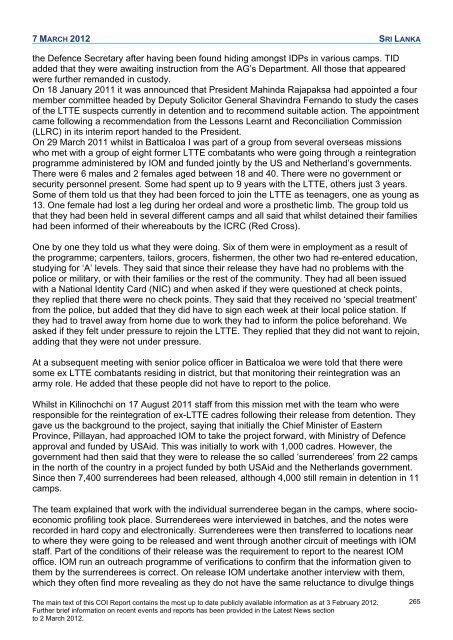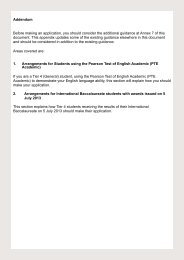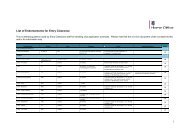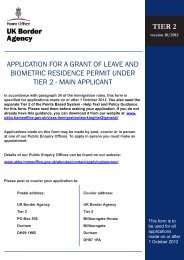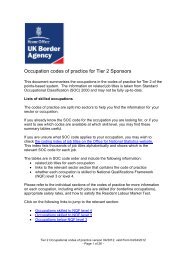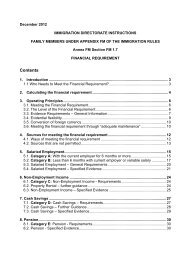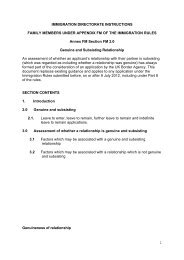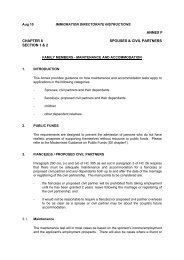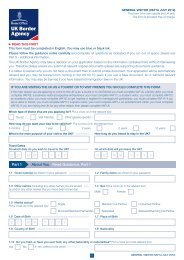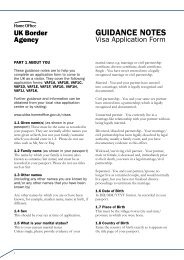COI Report March 2012 - UK Border Agency - Home Office
COI Report March 2012 - UK Border Agency - Home Office
COI Report March 2012 - UK Border Agency - Home Office
Create successful ePaper yourself
Turn your PDF publications into a flip-book with our unique Google optimized e-Paper software.
7 MARCH <strong>2012</strong> SRI LANKA<br />
the Defence Secretary after having been found hiding amongst IDPs in various camps. TID<br />
added that they were awaiting instruction from the AG‘s Department. All those that appeared<br />
were further remanded in custody.<br />
On 18 January 2011 it was announced that President Mahinda Rajapaksa had appointed a four<br />
member committee headed by Deputy Solicitor General Shavindra Fernando to study the cases<br />
of the LTTE suspects currently in detention and to recommend suitable action. The appointment<br />
came following a recommendation from the Lessons Learnt and Reconciliation Commission<br />
(LLRC) in its interim report handed to the President.<br />
On 29 <strong>March</strong> 2011 whilst in Batticaloa I was part of a group from several overseas missions<br />
who met with a group of eight former LTTE combatants who were going through a reintegration<br />
programme administered by IOM and funded jointly by the US and Netherland‘s governments.<br />
There were 6 males and 2 females aged between 18 and 40. There were no government or<br />
security personnel present. Some had spent up to 9 years with the LTTE, others just 3 years.<br />
Some of them told us that they had been forced to join the LTTE as teenagers, one as young as<br />
13. One female had lost a leg during her ordeal and wore a prosthetic limb. The group told us<br />
that they had been held in several different camps and all said that whilst detained their families<br />
had been informed of their whereabouts by the ICRC (Red Cross).<br />
One by one they told us what they were doing. Six of them were in employment as a result of<br />
the programme; carpenters, tailors, grocers, fishermen, the other two had re-entered education,<br />
studying for ‗A‘ levels. They said that since their release they have had no problems with the<br />
police or military, or with their families or the rest of the community. They had all been issued<br />
with a National Identity Card (NIC) and when asked if they were questioned at check points,<br />
they replied that there were no check points. They said that they received no ‗special treatment‘<br />
from the police, but added that they did have to sign each week at their local police station. If<br />
they had to travel away from home due to work they had to inform the police beforehand. We<br />
asked if they felt under pressure to rejoin the LTTE. They replied that they did not want to rejoin,<br />
adding that they were not under pressure.<br />
At a subsequent meeting with senior police officer in Batticaloa we were told that there were<br />
some ex LTTE combatants residing in district, but that monitoring their reintegration was an<br />
army role. He added that these people did not have to report to the police.<br />
Whilst in Kilinochchi on 17 August 2011 staff from this mission met with the team who were<br />
responsible for the reintegration of ex-LTTE cadres following their release from detention. They<br />
gave us the background to the project, saying that initially the Chief Minister of Eastern<br />
Province, Pillayan, had approached IOM to take the project forward, with Ministry of Defence<br />
approval and funded by USAid. This was initially to work with 1,000 cadres. However, the<br />
government had then said that they were to release the so called ‗surrenderees‘ from 22 camps<br />
in the north of the country in a project funded by both USAid and the Netherlands government.<br />
Since then 7,400 surrenderees had been released, although 4,000 still remain in detention in 11<br />
camps.<br />
The team explained that work with the individual surrenderee began in the camps, where socioeconomic<br />
profiling took place. Surrenderees were interviewed in batches, and the notes were<br />
recorded in hard copy and electronically. Surrenderees were then transferred to locations near<br />
to where they were going to be released and went through another circuit of meetings with IOM<br />
staff. Part of the conditions of their release was the requirement to report to the nearest IOM<br />
office. IOM run an outreach programme of verifications to confirm that the information given to<br />
them by the surrenderees is correct. On release IOM undertake another interview with them,<br />
which they often find more revealing as they do not have the same reluctance to divulge things<br />
The main text of this <strong>COI</strong> <strong>Report</strong> contains the most up to date publicly available information as at 3 February <strong>2012</strong>.<br />
Further brief information on recent events and reports has been provided in the Latest News section<br />
to 2 <strong>March</strong> <strong>2012</strong>.<br />
265


